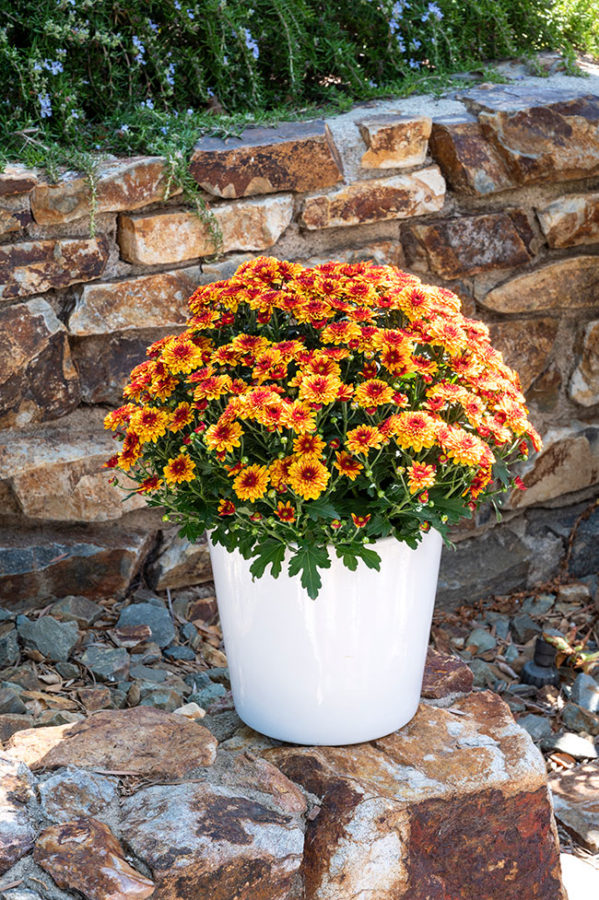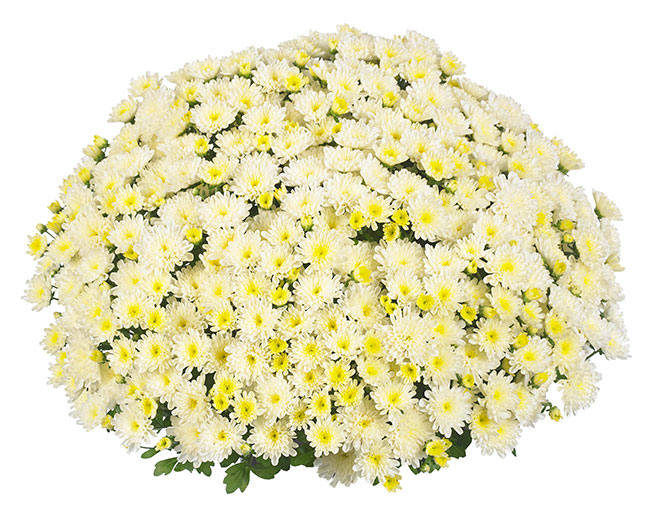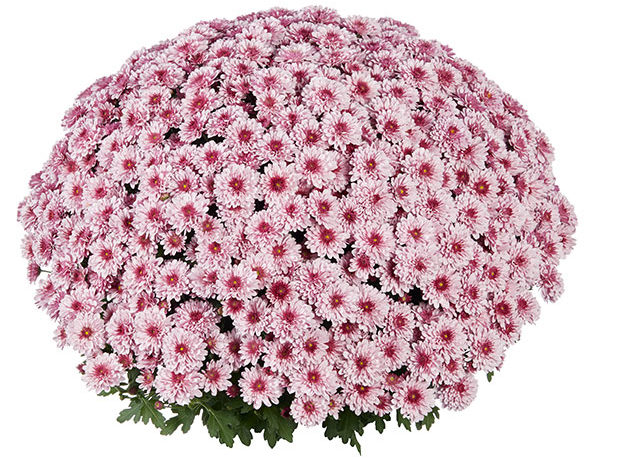
Culture Report — Intrinsa Garden Mums
While the multiflora chrysanthemum is native to Asia, garden mums are now ubiquitous autumn plants that offer an array of celebratory colors for harvest time throughout much of North America. The sea of yellow, oranges, and bronzes are accented with white, pinks, and purple as decorations on consumer doorsteps and patios and even spilling into the garden with plantings of packs and quarts or even over-wintered plants from the prior years. Dümmen Orange has launched Intrinsa garden mum technology from Europe to the doorsteps of consumers around the world.
Advanced Breeding
Following the recent opening of our Breeding Technology Centre in the Netherlands, we are now offering Intrinsa, a new brand that will be used to label Dümmen Orange’s product innovations coming from its research and development pipeline. Dümmen Orange aims to shape the future of the floricultural industry and believes in more technology-driven R&D to develop superior and sustainable genetics for customers, retailers, and global consumers.

Understanding is the key: There is no better teacher than nature. By deciphering and analyzing the genetic code of plants, we learn about the precise biological causes for existing or missing resistances. In the next step, Intrinsa uses and develops our knowledge of existing DNA code in commercial varieties by systematically improving and extending crucial traits of a plant. In this way, deficiencies are cured from within, making use of the plant’s intrinsic and natural capabilities. The results are plants that can withstand a multitude of biotic and abiotic stresses.
Plants benefit: No matter how much external conditions try to put pressure on a plant, these varieties stand strong. Intrinsa can offer both resistance against physiological influences (heat, cold, and drought) and resistance against biotic factors (certain bacteria, fungi, viruses, and insects).
Growers and value chain benefit: How much time, money and other resources have been invested by growers in trying to permanently keep all kinds of possible dangers away from their plants? Intrinsa helps growers by doing things right from the start. In addition, it’s perfectly clean: specific health, environmental or public relations concerns resulting from the use of chemical methods now belong to the past.
Within garden mums, a major disease is Chrysanthemum White Rust (CWR) which is a quarantinable disease in North America. While growers do their best to avoid this nuisance, breakouts occur and result in the entire crop being quarantined and destroyed. The Intrinsa breeding program has identified the perfect genetic patterns in chrysanthemum DNA for naturally occurring resistance against CWR. By targeting our breeding with this unique combination of genetics, our collection of chrysanthemums offers growers a bullet-proof insurance policy against white rust infections.
Series Highlights
Ditto: Dümmen Orange’s first white rust resistant family, the perfectly matched Ditto family, features a full range of colors, well-suited for monoculture or combinations. An early-season series that will naturally finish in early September and would be perfect for quarts, 6-inch pots, and hanging baskets. It is versatile for black out production for easy programmable production.

Homerun: This white rust resistant family features large flowers and is bred for a perfectly matched mid-season program. Homerun has a quick blackout response time of 6 weeks and excellent shelf life. This family series will finish naturally in mid-September and provide a great habit for mid- to large-sized containers.
Jamboree: The bicolor Jamboree family shows large, lavish flowers with eye-catching color. The white rust-resistant family offers a mounding habit to fit all program types and finish naturally in mid to late September.
Banquet: Celebrate the end of the season with the long flowering white rust resistant Banquet family. This family series offers strong colors that will WOW consumers. Great for both blackout and outdoor production with the perfect round habit fitting in multiple container sizes. This white rust resistant family is our latest flowering series and will naturally finish in mid-October.
Propagation

Stick unrooted cuttings upon arrival. If cuttings cannot be stuck upon arrival, store in a cooler at 35-40° F (2-4° C). Typical cell tray sizes are 36, 50, 72, 84, or 105. Cuttings may also be stuck directly in finishing container. To prevent premature bud set, provide long days using a 4-hour night interruption from 10 p.m. to 2 a.m. at a minimum of 10 foot candles.
Apply mist as needed to keep cuttings turgid, reducing frequency as roots form. If misting volume is high with leaching, add 50 ppm nitrogen from 17-5-17 to the mist solution. If mist volume is light with no leaching, use clear water only to avoid salt accumulation on the leaves. Once callus forms, apply 200 ppm nitrogen from 17-5-17 or 20-10-20 to charge the soil and then fertilize at 100-125 ppm N. Allow 14 days for rooting.
Finishing
Fertilize with a complete 17-5-17 fertilizer (or similar N to P ratio) immediately after planting for establishment and rapid growth. When fertilizing at a lower rate, minor nutrients may become deficient if not supplemented. Height management is important for successful garden mum production. There are two rules of thumb that are often useful in producing garden mums. 1) A plant not receiving a growth regulator will elongate about 1 inch per week following the start of short days. 2) Plant height (including the height of the pot) should be about 60% of the final height at the start of short days and reproductive development. Early bud set is promoted in mums by low temperatures and short day-length. To discourage premature bud set, use a combination of the following. Maintain night temperatures above 68° F (20° C). Ensure plants are under long days.
Critical daylength required to maintain vegetative growth is 15 hours or longer. Ethephon can also be used to discourage reproductive growth, beginning 7-10 days after stick. Depending on the cultivar natural response, Ethephon applications alone under short days and/or low temperatures may not be adequate to prevent early bud set. All applications should stop a half week earlier than the response timing.


 Video Library
Video Library 




















